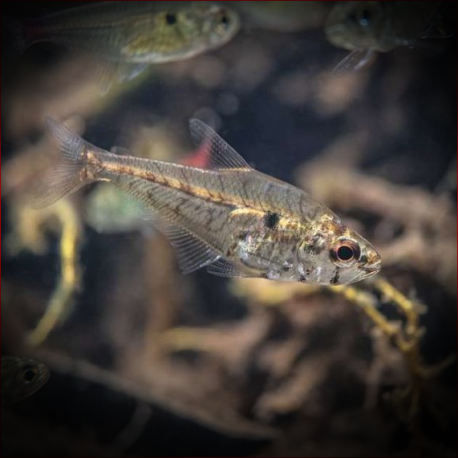More info
Datasheet
| Minimum Tank Size | 70 litres / 18.49 US gallons |
| Maximum Size | 5.5cm / 2.17inches |
| Temperature | 23°C / 73.40°F - 25°C / 77.00°F |
| Hardness | 0-20ºdH |
| pH | 6.0-7.4 |
General Description
The Small-Scale Glass Tetra, scientifically known as Charax Condei, is a rarely seen Characin species that originates from the Rio Negro basin in Brazil. This fish occasionally enters the aquarium trade as a byproduct among shipments of more popular species, with its presence noted in older literature under the name Asiphonichthys condei. With a maximum size of 5.5cm, it is a micropredatory fish that shows willingness to accept various aquarium foods.
Aquarium Setup
In captive environments, the Small-Scale Glass Tetra thrives best when kept in a group of at least 6, but preferably 10 or more individuals. Being a shoaling species by nature, it is recommended to maintain it in a mixed shoal with other characins, alongside species like Corydoras catfish, small Loricariids, and peaceful cichlids. The ideal tank setup includes a substrate of river sand, driftwood branches, twisted roots, and dried leaves to simulate its natural habitat. Aquatic plants are not necessary due to the species' natural waters lacking them.
Behaviour
Known for its non-aggressive nature, the Small-Scale Glass Tetra may pose a predation risk to significantly smaller tank mates. It is most visibly effective when maintained in groups, reflecting its shoaling tendency. Keeping this species alongside its own kind fosters a healthier and more natural behavior in the aquarium.
Feeding and Diet
In the wild, Small-Scale Glass Tetras feed on aquatic invertebrates and smaller fish, but in captivity, they readily accept various food types once acclimated. This species is not known to be finicky eaters, making it relatively easy to provide a suitable diet for them in a fish tank.
Reproduction & Dimorphism
While reproduction of the Small-Scale Glass Tetra in captivity has not been widely documented, it is believed to follow similar breeding patterns seen in other characin species. Sexual dimorphism in this species remains unreported, but mature females are likely to have a fuller body compared to males.
Habitat and Distribution
In its natural habitat, the Small-Scale Glass Tetra inhabits slow-moving blackwater streams, creeks, and tributaries in the Rio Negro basin. These water bodies are characterized by dark brown staining due to humic acids, resulting in low dissolved mineral content and extremely low pH levels. The dense rainforest canopy covering the water limits light penetration, while the substrate is often covered in fallen tree branches and decaying leaves.

